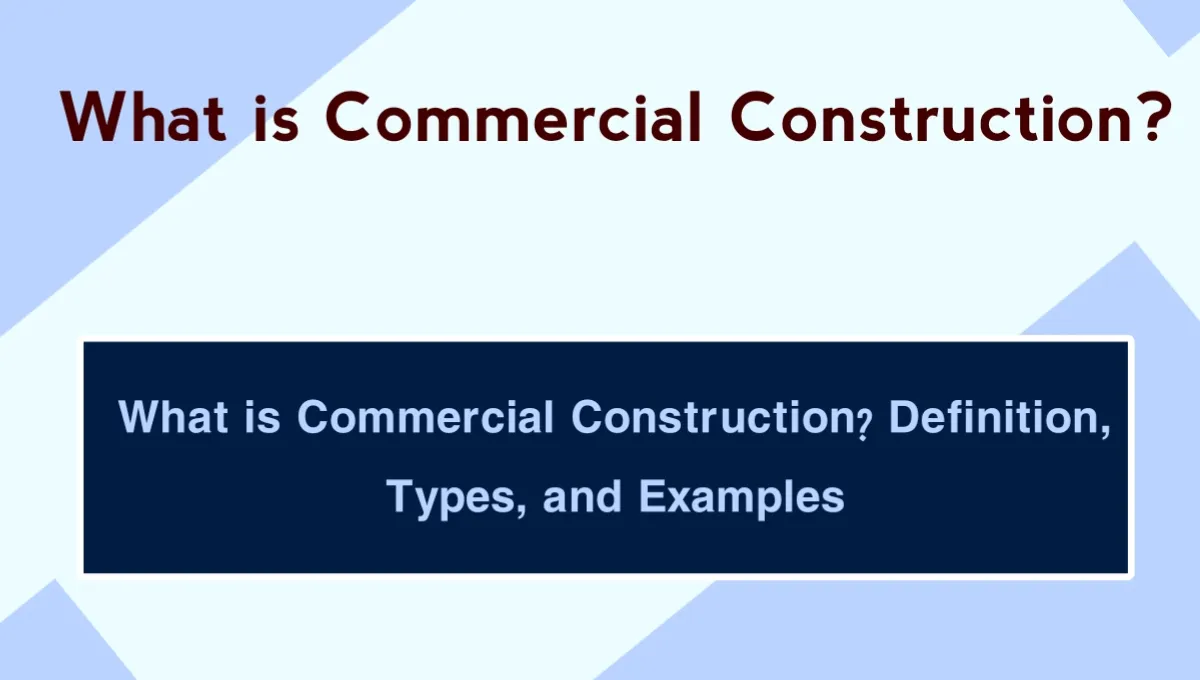What is Commercial Construction? Definition, Types, and Examples. In this post, we will dive deep into the definition, types, process, and examples of commercial construction to help you better understand this important field.
Commercial construction is a vital segment of the construction industry, focusing on the design, development, and building of structures intended for business use. From retail stores and office buildings to hospitals and hotels, commercial construction plays a central role in the growth of economies and urban development.
What is Commercial Construction
Definition of Commercial Construction
Commercial construction refers to the process of constructing buildings or facilities for commercial purposes, such as for retail, office spaces, hospitality, or manufacturing. Unlike residential construction which deals with individual homes, commercial projects are typically larger in scale, subject to strict regulations, and require coordination among multiple stakeholders.
These projects are built to accommodate business operations and are designed keeping in mind functionality, safety, accessibility, and efficiency.
Key Characteristics of Commercial Construction
- Purpose: Intended for business, trade, or public service use.
- Scale: Larger and more complex than residential projects.
- Materials: Use of high-grade materials like steel frames, reinforced concrete, glass facades, etc.
- Code Compliance: Must meet zoning laws, fire safety norms, environmental laws, and accessibility regulations (like ADA in the U.S.).
- Professional Involvement: Involves architects, structural engineers, MEP experts, contractors, and various consultants.
Types of Commercial Construction
Commercial construction projects can be classified based on their usage and complexity. Here are some major types:
1. Retail Construction
These include malls, standalone retail stores, supermarkets, and showrooms.
Example: Shopping malls like Phoenix Marketcity or Big Bazaar outlets.
2. Office Buildings
Includes low-rise or high-rise office complexes and business parks.
Example: Tech parks in cities like Bengaluru or Cyber City in Gurugram.
3. Hospitality Structures
Hotels, resorts, motels, and convention centers fall under this category.
Example: 5-star hotels like Marriott, ITC, or Oberoi properties.
4. Healthcare Facilities
Hospitals, clinics, and diagnostic centers with specialized requirements like sterilized environments and medical gas systems.
Example: AIIMS, Apollo Hospitals, and Max Healthcare buildings.
5. Institutional & Educational Buildings
Colleges, universities, training institutes, and research centers.
Example: IIT campuses, private universities, or government training centers.
6. Industrial & Manufacturing Units
Though considered separately at times, large-scale industrial buildings for production or warehousing also fall under commercial development when they serve business purposes.
Example: Auto manufacturing plants, logistics parks, or FMCG factories.
7. Mixed-Use Developments
Buildings that combine retail, office, and residential spaces in one complex.
Example: Brigade Gateway or Prestige Shantiniketan in Bengaluru.
Process Involved in Commercial Construction
Commercial construction involves several phases. Here’s a simplified overview:
1. Planning and Feasibility
- Land acquisition
- Zoning approval
- Budgetin
- Initial design concepts
2. Design and Permits
- Architectural, structural, and MEP designs
- Submission for permits and government clearances
3. Pre-construction
- Contractor selection
- Procurement planning
- Timeline and logistics setup
4. Construction
- Site preparation
- Foundation laying
- Superstructure, MEP works, interior finishing
5. Post-construction
- Testing & commissioning
- Final inspection
- Handover and occupancy
Commercial vs. Residential Construction: Key Differences
| Feature | Commercial Construction | Residential Construction |
| Purpose | Business/Institutional | Private living |
| Scale | Large-scale | Small to medium-scale |
| Cost | Higher | Lower comparatively |
| Design | Complex systems | Simpler layout |
| Regulations | Strict codes & approvals | Fewer regulations |
| Materials | Steel, concrete, fire-rated components | Brick, wood, standard materials |
Advantages of Commercial Construction
- Boosts local economies by creating jobs and infrastructure.
- Encourages real estate development and urban expansion.
- Meets the growing demand for office and retail space.
- Introduces modern, sustainable technologies (green buildings, smart systems).
Real-World Examples
- DLF Cyber City – Gurugram A large business park housing top MNCs, with office towers, retail spaces, and integrated transport.
- Phoenix Marketcity – Mumbai/Bangalore One of India’s biggest malls combining retail, food, entertainment, and event spaces.
- Infosys Campus – Mysuru A modern training and business facility built for large-scale employee development.
Conclusion Commercial construction is a cornerstone of modern development, touching nearly every aspect of our day-to-day lives—from where we shop and work to where we receive medical care or attend classes. With the growing demand for smart and sustainable spaces, this sector continues to evolve, offering immense opportunities for professionals, investors, and contractors alike.
FAQs
1. What is considered a commercial building?
A1. A commercial building is any structure used for business purposes like offices, retail stores, warehouses, hotels, or hospitals.
2. How is commercial construction different from residential construction?
A2. Commercial projects are larger, more complex, require more permits, and are meant for public or business use, unlike residential homes.
3. What qualifications do you need to work in commercial construction?
A3. It varies by role, but civil engineers, architects, site managers, and skilled trades typically require a diploma or degree in their field.
4. What are the costs involved in commercial construction?
A4. Costs depend on size, materials, design, location, and labor. Typically, commercial construction is significantly more expensive than residential.
5. What materials are used in commercial buildings?
A5. Steel, reinforced concrete, fireproof insulation, aluminum, high-grade glass, and advanced HVAC systems are commonly used.
6. Who manages commercial construction projects?
A6. Usually handled by general contractors, project managers, or construction management firms coordinating with architects and engineers.
7. What permits are required for commercial construction?
A7. Land use permits, environmental clearance, fire safety approval, building plan sanction, and occupation certificates, depending on local laws.
| Types of Foundations in Building Construction | Read More |
| 10 Civil Engineering Interview Questions and Answers for Freshers 2025 | Read More |
| Importance of Quality Control in Construction Projects | Read More |
Homepage: Click Here

